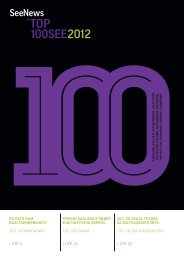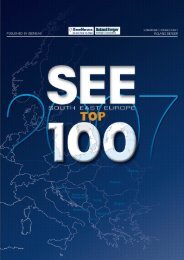корица 1 парциален лак - SEE Top 100 - SeeNews
корица 1 парциален лак - SEE Top 100 - SeeNews
корица 1 парциален лак - SEE Top 100 - SeeNews
You also want an ePaper? Increase the reach of your titles
YUMPU automatically turns print PDFs into web optimized ePapers that Google loves.
www.top<strong>100</strong>.seenews.com<br />
telecommunications market in the EU and<br />
<strong>SEE</strong> countries. In 2009 the average mobile<br />
penetration in <strong>SEE</strong> was 111%, still below the<br />
EU-27 average of 127%. However, mobile<br />
penetration continued to grow in all <strong>SEE</strong><br />
countries except Macedonia, reaching and<br />
sometimes exceeding the EU-27 level. At the<br />
head were Bulgaria, with a penetration rate<br />
of 141%, Croatia with 137% and Albania<br />
with 132%.<br />
The growth of mobile penetration was<br />
accompanied by intensified competition<br />
and falling retail prices. Macedonia, Albania,<br />
Montenegro, Serbia and Kosovo saw a<br />
significant drop of retail mobile prices.<br />
However, especially in Bulgaria, consumer<br />
prices for calls between different mobile<br />
networks (off-net) are still significantly higher<br />
than prices for calls within a single network<br />
(on-net) thus forcing consumers to hold more<br />
than one mobile subscription.<br />
Regarding mobile number portability,<br />
Kosovo, Albania, Montenegro, Serbia and<br />
Moldova failed to introduce the service in<br />
2009. In Serbia mobile number portability<br />
will be introduced in January 2011.<br />
The growth of the mobile broadband<br />
continued with 3G mobile services now<br />
available in most <strong>SEE</strong> countries. Dedicated<br />
mobile data cards in Croatia achieved 4.5%<br />
penetration, surpassing the EU-27 average of<br />
4.2%. However, in terms of 3G penetration,<br />
the level in Eastern and Southeastern Europe<br />
of 15.1% was considerably lower than in<br />
the Western European countries, where it<br />
reached 37.6% in 2009.<br />
3G MOBILE SERVICES<br />
Growing 3G penetration boosted mobile<br />
internet revenue but 3G services still account<br />
for only a small share of the total revenue of<br />
the mobile telephony operators. The revenue<br />
from mobile internet in Bulgaria for 2008<br />
made only 1.0% of the local sector’s total<br />
revenue, while for the EU-27 the average<br />
rate was 4.0%.<br />
The 3G mobile services are pushing up handset<br />
sales and data transfer revenue of telecom<br />
operators across Southeastern Europe as the<br />
region aims to catch up with Western Europe<br />
where the smartphone penetration rate is<br />
already at around 18%, according to an analysis<br />
published by <strong>SeeNews</strong> in July 2010.<br />
In Croatia smartphones already account for<br />
a third of the handsets sold by the country’s<br />
iPhone carrier Hrvatski Telekom (T-HT).<br />
Vipnet, another wireless carrier in Croatia, also<br />
said it sees constant growth in smartphone sales.<br />
5<br />
4<br />
3<br />
2<br />
1<br />
0<br />
Market share in %<br />
Penetration (%)<br />
<strong>100</strong><br />
90<br />
80<br />
70<br />
60<br />
50<br />
40<br />
30<br />
20<br />
10<br />
0<br />
140<br />
120<br />
<strong>100</strong><br />
80<br />
60<br />
40<br />
20<br />
0<br />
<strong>SEE</strong> TOP Industry Profiles<br />
Number of Fixed Telephone Lines (in millions)<br />
2009 2008<br />
Romania Serbia Bulgaria<br />
Croatia Bosnia and Herzegovina Slovenia<br />
Macedonia<br />
Montenegro<br />
Albania<br />
Market Shares of Incumbent Fixed-line Operators<br />
in Some <strong>SEE</strong> Countries (in terms of subscribers)<br />
2008 2007<br />
Bulgaria Croatia Moldova Montenegro Romania Serbia Slovenia<br />
Mobile Telephony Penetration Rate in <strong>SEE</strong><br />
Bulgaria Croatia Albania<br />
Montenegro Romania Slovenia<br />
In Macedonia smartphones made up 3.0%<br />
of mobile handset sales at mobile telephony<br />
operator T-Mobile, the iPhone carrier on the<br />
local market. The company expects the sales<br />
of smartphones to rise thanks to the new types<br />
of operating system installed in the phones<br />
and new services to be offered.<br />
With Bulgarian mobile carrier GLOBUL<br />
smartphone users account for around 13%<br />
of the customers and their share continues<br />
to grow. Although voice services continue<br />
to be the dominant segment of mobile<br />
communications, the use of data transfer<br />
Source: International Telecommunication Union (ITU)<br />
Source: CRC; HAKOM; ANRCETI; EKIP; ANCOM; RATEL; APEK<br />
2009 2008<br />
Serbia<br />
Macedonia<br />
Bosnia and Herzegovina<br />
Moldova<br />
<strong>SEE</strong> TOP Industry Profiles<br />
Source: ITU<br />
services by GLOBUL subscribers has seen<br />
three-digit growth since 2007.<br />
Smartphones as of July 2010 made up 15-16%<br />
of the handset sales of Bulgaria’s incumbent<br />
telecommunications company Vivacom, which<br />
provides both fixed-line and mobile services.<br />
The smartphone penetration rate in Bulgaria<br />
was 4.0% in 2009, significantly below the<br />
global average of 18%, according to LG<br />
Electronics Bulgaria. The low penetration<br />
rate gives the segment an opportunity for<br />
strong growth in the future. LG Electronics<br />
Bulgaria expects that smartphone sales in<br />
49<br />
page 49





